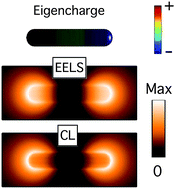Mapping plasmons at the nanometer scale in an electron microscope
Abstract
In this tutorial review, we present the use of electron energy loss spectroscopy (EELS) and cathodoluminescence (CL) spectroscopy for surface plasmon mapping within metallic nanoparticles. We put a special emphasis on particles that are much smaller than the wavelength of visible light. We start by introducing the concept of surface plasmons, keeping the formalism as simple as possible by focusing on the quasi-static approximation. We then make a link between optical cross-sections, EELS and CL probabilities, and the surface plasmons' physical properties. A short survey of simulation tools is given. We then present typical experimental set-ups and describe some problems frequently encountered with spectrometers. Experimental conditions for improved signal to noise ratio are discussed. Analysis techniques are discussed, especially those related to the spectral imaging mode, which is extremely useful in EELS and CL experiments. Finally, the specific range of applications of EELS and CL with respect to other nano-optic techniques is discussed, as well as the strengths and weaknesses of EELS as compared with CL.

- This article is part of the themed collection: Nanoplasmonics

 Please wait while we load your content...
Please wait while we load your content...